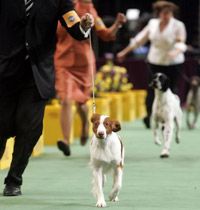The Road to Best in Show
Out of several hundred distinct dog breeds that exist, the AKC only recognizes a little more than 150 [source: AKC]. The AKC then separates these breeds into groups that loosely distinguish them based on what they were bred to do. These groups are:
- Sporting dogs: People breed these dogs for sporting purposes, such as hunting. This group includes pointers, retrievers, setters and spaniels.
- Hounds: Hounds, such as beagles, bloodhounds and dachshunds, often have exceptional senses of smell or physical endurance that can make them effective hunters.
- Working dogs: With large sizes and great strength, the dogs in this group make great assets in practical tasks such as search-and-rescue and guarding your home. Examples include Great Danes, rottweilers and Saint Bernards.
- Terriers: This group includes all terriers, who are known for their unique and energetic personalities. Examples include bull terriers, Scottish terriers, and miniature schnauzers.
- Toy dogs: This group includes small dogs, such as the Chihuahua that you'll often see Paris Hilton carrying around. Toy dogs include shih tzus, poodles, and pugs.
- Non-sporting dogs: This is a catch-all category for breeds that don't have any unifying characteristics. It includes the bulldog, dalmation, and American Eskimo dog.
- Herding dogs: As the name implies, people breed these dogs to herd animals such as sheep and cows. Breeds in this group include collies, Australian shepherds, and briards.
- Miscellaneous: As part of the process of recognition, the AKC allows breeds into this group that have generated popularity and interest over a wide area. Breeds in this group, however, cannot earn championship points in conformation shows. If the breeding activity grows for a breed in this class, the AKC might recognize it in one of the other groups.
[source: AKC]
Advertisement
Best of Breeds in each group compete against each other in group shows. If a dog wins first prize at its group show, then it goes on to compete in an All-Breed show, like Westminster. In an All-Breed show, before dogs compete against other groups, they must defeat other first-prize winners in their group. Finally, after the judges have narrowed it down to seven winners from the seven different groups (the miscellaneous group cannot compete), they award Best in Show, the highest prize, to the best dog.
The meticulous judging process and heated competition explains why people get so passionate about their show dogs, despite the fact that there is no significant prize at the end of the road. But, is this system ultimately bad for dogs? Find out on the next page what critics say about dog shows.
